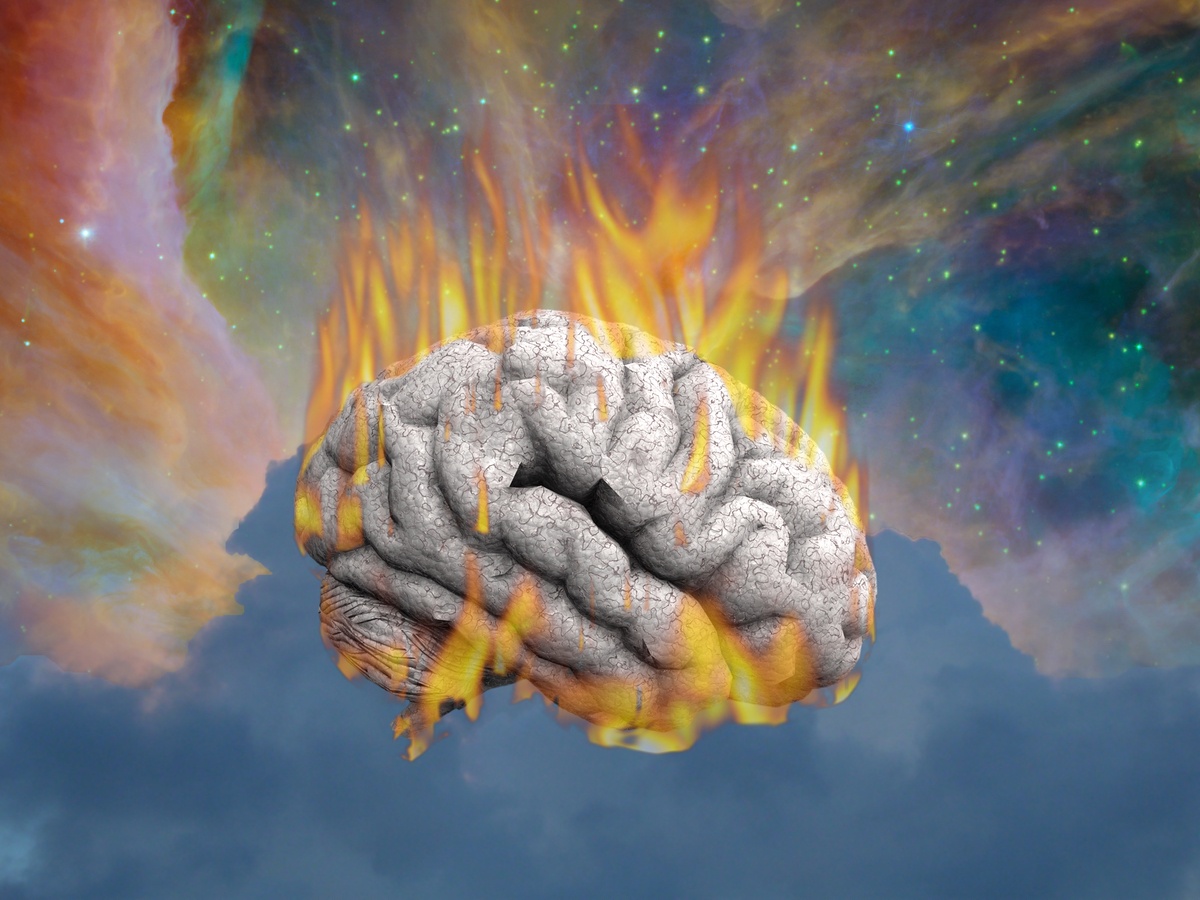ADD - Type 7
Here we are at tht end of the series of articles on the seven types of attention deficit.
Type 7 is also called Anxious ADD. The name for this type of ADD comes from the combination of ADD symptoms and anxiety symptoms. When these two come together, the ADD symptom become magnified. At Johnson Chiropractic Neurology & Nutrition & Michigan Brain Health (website that details my mental fitness treatment paradigm) we look at brain maps or qEEG's. The brain maps have a color coding to indicate the degree of brainwave activity as well as the assymetry of brainwaves. Red and yellow colors indicate higher than normal brain wave activity. When we see light and dark blue we know there is lower that normal brain wave activity. In Anxious ADD, it is common to see red and/or yellow in the alpha brainwaves (and sometime in beta) on the magnitude portion of the brain map clinician report. Typically the beta waves are predominant on the right side of the brain with anxiety as well on the assymety portion of the clinician report.
In Anxious ADD, it is very common to see the core ADD symptoms plus fear of being judged, predicting the worst, being conflict avoidant, and having physical stress symptoms, such as headaches and stomachaches. In addition, people with this type tend to freeze in anxiety-provoking situations, especially where they may be judged, such as in test taking. [1] As with all the other ADD types, a we correlate the patient's qEEG findings with their clinical history and brain map (qEEG) results will assist with correct ADD/ADHD classification.
Read More
Topics:
ADHD,
Neurofeedback,
Functional Neurology,
Nutritional Help,
Type 7 ADD,
Anxious ADD
ADD - Type 6
Now about Type 6 attention deficit in the series of articles where I explain some of the details of the seven types of ADD.
Type 6 is also called Ring of Fire ADD. The name for this type of ADD comes from underlying aspects of body chemistry imbalance that drives an overall increase in brain activity across the whole cortex. At Johnson Chiropractic Neurology & Nutrition & Michigan Brain Health (my new upcoming name for my mental fitness treatment paradigm) we look at brain maps or qEEG's. The brain maps have a color coding to indicate the degree of brainwave activity. Red and yellow colors indicate higher than normal brain wave activity. When we see light and dark blue we know there is lower that normal brain wave activity. In Ring of Fire ADD, we typically see an overall pattern of red and yellow in all the 4 brainwaves (delta, theta, alpha and beta). Dr. Amen postulates that, "Ring of Fire ADD may represent a variant of bipolar disorder mixed with ADD."
In Ring of Fire ADD, the core ADD symptoms are present along with the additional hallmark symptoms including; irritability, hyperactivity, excessive talking, overfocus issues, extreme oppositional behavior, and cyclic periods of calm behavior alternating with intense aggressive behavior. [1] As with all the other ADD types, a we correlate the patient's qEEG findings with their clinical history and brain map (qEEG) results will assist with correct ADD/ADHD classification.
Read More
Topics:
ADHD,
Neurofeedback,
Functional Neurology,
Nutritional Help,
Type 6 ADD
ADD - Type 5
Here we are, already, at part five in the series of articles where I explain some of the details of the seven types of ADD.
Type 5 is also called Limbic ADD. This type of ADD is where depression and ADD intersect each other. The core ADD symptoms are present with the additional symptoms of negativity, moodiness, sadness, low energy, lower motivation and a decreased zest for living. Typically, we want our cognitive areas of the brain to have increased activity and our emotional center to be less active, which will create a generally positive, more hopeful, centered state of mind. In Limbic ADD, as this emotional area of our brain (limbic area) increases in activity, we tend to develop a more negative outlook on life.
"Limbic ADD is often responsible for failed marriages. The low sexual interest, tiredness, feelings of being constantly overwhelmed, and lack of attention to detail often cause marital conflict. Treating Limbic ADD can literally save families and change a person’s life." [1]
As with all the other ADD types, a we correlate the patient's qEEG findings with their clinical history. To be accurate in our evaluation, when we see negativity, low motivation, low energy, depression, which is common in Type 5 ADD, correlating history and brain map (QEEG) results will assist with correct ADD/ADHD classification.
Read More
Topics:
ADHD,
Neurofeedback,
Functional Neurology,
Nutritional Help,
Type 5 ADD
ADD - Type 4
Welcome to part four of the series of articles where I explain some of the details of the seven types of ADD.
Type 4 is also called Temporal Lobe ADD. The temporal lobes are the part of the brain near your temple area and behind your eyes. Temporal lobes have a lot to do with emotionality, memory, learning, mood stability and visual processing of objects. So, when we run a brain map (qEEG), we look for different patterns, and Type 4 is one of those patterns that we look for. As with all the other ADD types, we correlate the qEEG findings with the patient's clinical history. Although moodiness, agressiveness and memory problems are notable with Type 4 ADD, the best way to determine the type of ADHD is by using patient history and
brain mapping (QEEG) in order for the ADD/ADHD classifications to be more accurately determined.
Type 4, is also called
Temporal Lobe
ADD. "Temporal Lobe ADD is commonly associated with learning and behavioral problems. It is often seen in people with ADD who struggle with mood instability, irritability, dyslexia, and memory problems.
Associated with domestic violence and suicidal thoughts, this type of ADD can ruin a family." [1]
When we have a temporal lobe issue, we can have somebody that's maybe morally rigid in their view of the world. They might have unpredictable moods. They might be angry. These kids kind of struggle to get to know people and have relationships, so they may interpret comments towards them as negative even when they're not. They tend to have a darker, negative view of the world. They may have had a history of head trauma, which could be a full-blown concussion even a mild head injury.
Read More
Topics:
ADHD,
Neurofeedback,
Functional Neurology,
Nutritional Help,
Type 4 ADD
ADD - Type 3
Welcome to part three of the series of articles where I explain some of the details of the seven types of ADD. In a way Type 3 ADD is opposite of type 1. Imagine someone being so overfocused that they seem to not be paying attention, but rather they are hyperfocused and have issues with shifting attention. Even though the tendency to overfocus is a key attribute of Type 3 ADD, the best way to determine the type of ADHD is by using patient history and
brain mapping (QEEG) and the ADD/ADHD classifications can be more accurately determined.
Type 3, also called
Overfocused
ADD. Those with overfocused ADD tend to have excessive activity in the middle of the brain. Because they have trouble shifting attention it makes them appear as though they cannot pay attention. Those with type 3 often have hard time with change and also often have difficulties with clothing. They may also have Obsessive Compulsive Disorder (OCD) or Obsessive Compulsive Personality Disorder (OCPD), more commonly seen in children and grandchildren of alcoholics and substance abusers. Tourette’s Syndrome AKA Gilles De La Tourette’s Syndrome is also associated with Type 3. A person with Tourette’s can have tics that are vocal and/or motor in nature (or both). It is estimated that 60% of those with Tourette’s Syndrome (TS) have ADD
Read More
Topics:
ADHD,
Neurofeedback,
Functional Neurology,
Nutritional Help,
Type 3 ADD
ADD - Type 2
This is the second part of the series of articles where I explain some of the details of the seven types of ADD. Type 2 ADD is quite a bit different than type 1. Remember the best way to determine the type of ADHD is by using patient history and
brain mapping (QEEG) and the ADD/ADHD classifications can be more accurately determined.
Type 2, also called
Inattentive ADD. This type is described as daydreamers, space cadets, or couch potatoes. Their brain map reveals a high theta overall. Many of these cases never get diagnosed or treated and clinicians often tend to tire of treating many of these kids and adults. They are seen as couch potatoes. In class they often daydream and are lost in themselves. They have trouble finding interests and motivation. This type of ADD is more commonly seen in females.
Read More
Topics:
ADHD,
Neurofeedback,
Functional Neurology,
Nutritional Help,
Type 2 ADD
ADD - Type 1
Daniel Amen, MD[1] describes 7 types/subtypes of the ADD/ADHD spectrum.
For many years, it was thought that there was only one brain pattern that defined ADHD. It was the work of Dr. Daniel Amen that made a large portion of healthcare providers accept the concept of multiple forms of ADD. By using patient history and
brain mapping (QEEG), the ADD/ADHD classifications can be ascertained.
Type 1 ADD is cosidered
Classic ADD and is also called
ADHD. We often find the child or adult has touble concentrating, hyperactivity, restlessness, impulsiveness, disorganization, and distractibility characterize this type of ADD. In neurofeedback circles, type 1 is also known as classic ADD.
There is a distinct neurological finding in Type 1 cases. These cases show high theta waves (4-7 hertz) in the front portion of the brain along with low beta waves (13-30 hertz) in the front portion of the brain. Type 1 shows up mostly in boys at a 3:1 - 4:1 ratio over girls.
Read More
Topics:
ADHD,
Neurofeedback,
Functional Neurology,
Nutritional Help,
Type 1 ADD










